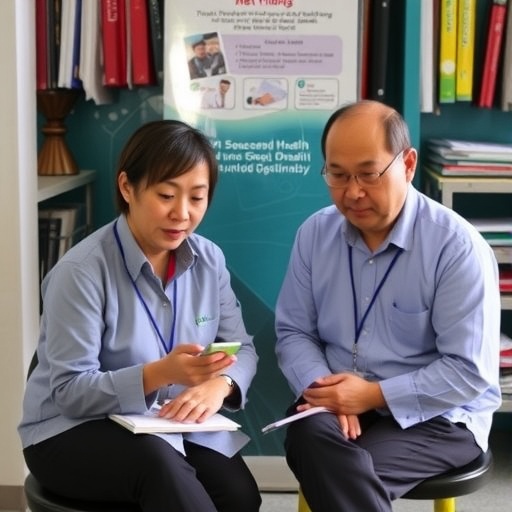In recent years, the pursuit of universal health coverage (UHC) has become a pivotal objective for health systems worldwide, with particular emphasis on ensuring robust financial risk protection for all citizens. A groundbreaking study conducted by Nguyen and Le, published in the International Journal for Equity in Health, sheds new light on the substantial progress and persistent inequalities in financial risk protection within Vietnam’s health sector. This comprehensive research offers a technical and nuanced understanding of the multidimensional challenges and achievements faced by Vietnam as it steadily advances toward the ambitious goal of UHC.
Vietnam has long been recognized for its dedicated efforts to enhance healthcare accessibility and affordability amid limited resources and a rapidly changing socio-economic landscape. Financial risk protection—essentially safeguarding individuals against catastrophic health expenditures—is one of the central pillars underpinning the trajectory toward universal health coverage. Nguyen and Le’s work meticulously dissects this concept through rigorous quantitative and qualitative analyses, revealing how policy frameworks, economic disparities, and systemic inefficiencies interplay to influence health equity outcomes.
The research delves deeply into Vietnam’s health financing mechanisms, exhibiting how the expansion of social health insurance has been instrumental in mitigating out-of-pocket expenditures which historically have imposed significant financial burdens on the most vulnerable populations. However, the authors caution that despite notable improvements, glaring inequalities persist. These disparities are particularly stark when considering geographic location, income levels, and demographic factors such as age and employment status, which collectively modulate individuals’ risk of financial hardship due to illness.
A salient feature of the study is its sophisticated statistical modeling that captures spatial and temporal trends of financial risk exposure across Vietnam’s heterogeneous provinces. This approach unveils that although urban centers and wealthier regions have witnessed marked improvements, rural and remote areas remain disproportionately susceptible to impoverishment following medical emergencies. This geographic inequity underscores the critical need for policy interventions that are finely tuned to the unique contextual realities of each locality.
Moreover, Nguyen and Le probe the indirect costs associated with healthcare utilization—including transportation, lost income, and informal payments—that frequently evade conventional accounting but compound the economic strain on households. These hidden expenses exacerbate vulnerability, demonstrating that merely expanding insurance coverage is insufficient unless it concurrently addresses the broader socioeconomic contours shaping access to care.
One of the technical advancements showcased in the paper is the application of multidimensional poverty indices combined with health expenditure data. This methodological innovation allows for a more granular and holistic measurement of financial risk protection, moving beyond simplistic income-based metrics. By integrating socio-economic vulnerabilities with health system performance indicators, the study presents a sophisticated framework that can inform more equitable resource allocation and targeted social protection schemes.
From a policy perspective, the findings presented by Nguyen and Le resonate with the broader global discourse on health equity, particularly in low- and middle-income countries grappling with the dual burden of communicable and non-communicable diseases. The authors advocate for multi-sectoral collaboration, emphasizing that health insurance reforms must be complemented by improvements in service quality, infrastructure development, and poverty alleviation strategies to achieve sustainable equity in health financing.
Importantly, the investigation highlights the role of community engagement and local governance in bolstering financial risk protection. Decentralized decision-making fosters more responsive and culturally appropriate interventions, which are critical in addressing the heterogeneous needs of Vietnam’s diverse population. This bottom-up approach could act as a catalyst in diminishing financial barriers that prevent health service utilization among marginalized groups.
Furthermore, the analysis illuminates how demographic transitions, including aging populations and urban migration, pose emerging challenges to financial risk frameworks. The increasing prevalence of chronic conditions necessitates adaptive financing models that prioritize long-term affordability and continuity of care, emphasizing preventative strategies alongside curative services.
Nguyen and Le’s study also integrates international comparisons, positioning Vietnam’s journey within the global movement toward UHC. By benchmarking against countries with varying health financing structures, the authors identify best practices and cautionary lessons, fostering a dynamic exchange of knowledge that is essential for policy innovation.
The implications of this research extend beyond academic discourse, as healthcare policymakers, practitioners, and civil society stakeholders gain actionable insights from its findings. By illuminating the complex matrix of factors perpetuating inequalities in financial risk protection, the study equips decision-makers with evidence-based strategies to optimize health financing reforms and close persistent gaps.
As Vietnam continues to navigate the intricate pathway toward universal health coverage, the dual imperatives of progress and equity remain intertwined. Nguyen and Le’s rigorous and methodologically advanced research exemplifies how robust scientific inquiry can elucidate the nuanced realities of health system performance, offering a beacon for other middle-income nations striving for inclusive and financially secure healthcare landscapes.
In summary, the study encapsulates the critical nexus between health financing policies and social equity, demonstrating that achieving universal health coverage is not merely a technical challenge but a profound socio-political endeavor. Vietnam’s experience, as illuminated through this incisive analysis, reaffirms that sustainable health equity demands persistent vigilance, innovative financing mechanisms, and unwavering commitment to the health rights of all individuals.
This research marks a significant contribution to the field of health economics and policy, providing a template for in-depth evaluation of financial risk protection in transitional health systems. Its forward-looking recommendations call for integrating technological advancements, data analytics, and participatory governance to overcome existing barriers and propel the vision of universal health coverage into tangible reality in Vietnam and beyond.
Subject of Research: Financial risk protection and universal health coverage equity in Vietnam.
Article Title: Progress and inequalities in financial risk protection toward universal health coverage: insights from Vietnam.
Article References:
Nguyen, P.T., Le, P.M. Progress and inequalities in financial risk protection toward universal health coverage: insights from Vietnam. Int J Equity Health 24, 287 (2025). https://doi.org/10.1186/s12939-025-02659-0
Image Credits: AI Generated




